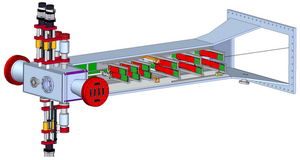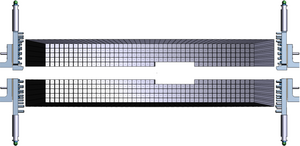The HPS Run Wiki
Phone NumbersShift ScheduleShift-Taker's ChecklistHot CheckoutBeam Time AccountingRun Spreadsheet 2021 2019,2016, 20152019-2021 HPS triggers descriptionsCOO, ESAD, RSAD Things to read before shift.Expert shift - refresher video demoRemote worker shift - requirements and responsibilitiesHPS 2021 Run discription and beam parameter requirements |
Procedures
|
Manuals |
JLab Logbooks
|
HPS (E12-11-006) 2021 run, August - October'
Beam energy 3.74 GeV
Important: Document all your work in the logbook!
Bluejeans for Run Meetings on DAY and DAY at 3 pm
RC: Stepan Stepanyan
- (757) 575-7540
- 9 575 7540 from Counting Room
- Personal cell: +1 (757) 753-7769
PDL: Valery Kubarovsky
- (757) 876-1789
- 9 876-1789 from Counting Room
Important instructions
* Turn OFF beam before target move!
* No access to the alcove if the chicane magnet beacon is ON.
Chicane magnets must be OFF if the hall is in Controlled access and access to the alcove is needed or when the hall is in Restricted access. If Chicane magnets are OFF, they can be energized only when the hall is in Power or Beam Permit, [1].
* Energizing the chicane: Please read the "Turning Chicane ONN/OFF" document and ask if anything is not clear. When you pushe the ON button make sure current readbacks will behave as it is described in the scction III "Sequenc details"
* TURN OFF the chicane magnet if beam is not available due to a thunderstorm. Loss off power would seriously damage detectors.
* Fill out BTA hourly. Click "Load from EPICS" to fill the left side, then make sure numbers are correct. If needed edit the entry.
NO ABUs or BANU if beam tune is in progress, make it all BNA with ER 100%. At the end of the shift save BTA to the logbook!
* Please close any GUI that is not being used, e.g. close harp scanner after harp scan is done, close chicane, after chicane is ON, etc.
* For orbit lock positions on 2H00(X=0.3,Y=-1.) and on 2H02(X=-2.7,Y=-0.9). Use the 2.82 mm SVT collimator
Before 9/9 this was: 2H00(X=0.3,Y=-1.) and on 2H02(X=-2.4,Y=-1.). Use the 2.82 mm SVT collimator
Run Plan October 7 - 8, 2021
Beam up time)
Hall Access Items (Tuesday, October 5):Every Shift:
Every Run:
SVT Bias Currents:Shifters must pay attention to the L0 bias currents. This is on both the SVT motor GUI and the main bias GUI. The bias currents will slowly creep up over the course of a run. When the bias current is between 15-20 uA for either L0 sensor, do the following:
Do not let the bias current exceed 20 uA. It takes about 4-5 hours for the bias currents to creep up to those values. Call SVT expert if unsure. Harp Scan Procedure:
Important Notes:
|
General InstructionsEstablishing Physics Quality Beam for HPS:
Note: in order to have reliable readings on two important for HPS BPMs, 2H00 and 2H02, beam current should be >30 nA.
|
|
|
|---|
RC daily meetings at 3 pm in the counting-house 2nd-floor conference room.
BlueJeans Info:
URL: https://bluejeans.com/759437905/8110
Meeting ID: 759437905
|
|
| ||||||||||||||||||||||||||||||||||||||||||||||||||||||||
|
Webcams:
|
Accelerator: |
Slow Controls:
|
Online & Offline: |
| System/Person | Pager/Phone Number |
|---|---|
| Run Coordinator | (757) 575-7540 (cell) |
| Physics Div. Liaison | (757) 876-1789 (cell) |
| MCC-OPS | 7048 |
| Crew Chief | 7045 |
| Crew Chief | 9-879-3367 (cell) |
| Program Deputy | 9-876-7997 (cell) |
| Gate House Guard | 5822 |
| DAQ/Online | (757) 869-2188 (cell) |
| SVT | (757) 329-4844 (cell) |
| ECAL/Hodo | (757) 310-7198 (cell) |
| Slow Controls | (757) 748-6922 (cell) |
| Beamline | (757) 303-3996 (cell) |
| Engineering | (757) 748-5048 |
| Hall-B Floor | 5165 |
| Hall-B Space Frame | 5170, 5171 |
| Hall-B Forward Carriage | 5371 |
| Hall-B Counting Room | 5244(Shift1), 5245(Shift2) |
| Hall-B Counting Room | 5247(Expert), 5502(Target) |
| Hall-B Counting Room | 5246(RC1), 5126(RC2) |
| Hall-B Gas Shed | 7115 |
Overview
Tasks
|
Shift Worker Backup TableTo add your name, edit this wiki page or send email to Maurik or Nathan.
| |||||||||||||||||||||||||||||||||||||||||||||||||||||||||||||||||||||||||||||||||||||||||||||||||||||||||||||||||||||||||||||||||||||||||||||||||||||||||||||||||

